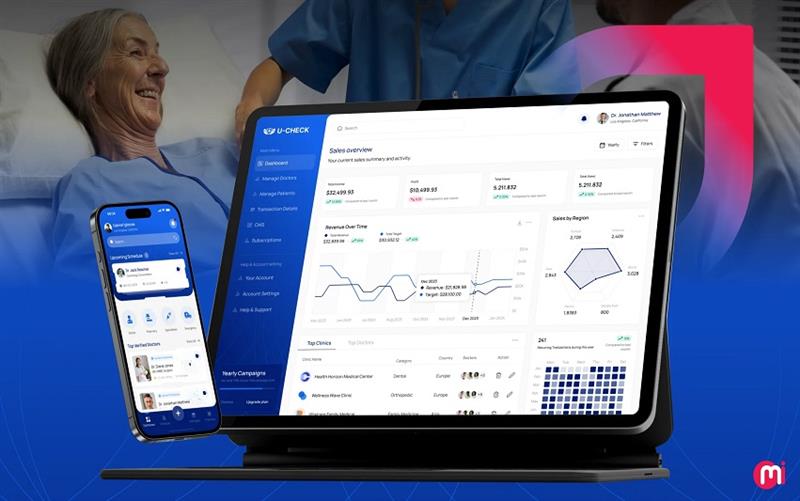
The delivery of healthcare is being redefined by software. It is assisting in the improvement of care systems' resilience, patient education, and provider efficiency. The need for intelligent, safe, and scalable software solutions is growing along with the difficulties.
A digital revolution is about to occur in the healthcare sector. Today's software is establishing the groundwork for the next wave of breakthroughs, which will include wearable health technology, blockchain-based records, and artificial intelligence.
True transformation, however, involves more than just using tools; it also entails strategically integrating them, educating personnel, and placing patients at the core of all innovations.
Smart digital solutions are filling the gaps in healthcare systems as they deal with increasing patient demands, complicated data administration, and the growing requirement for distant care. Let's examine why software is now more crucial than ever in improving the delivery of healthcare and what it implies for patients, providers, and the field's future.
How Software Is Revolutionizing Healthcare Delivery
1. Improved Patient Care and Safety
Accurate, current, and instantaneous patient information is guaranteed by healthcare software. Electronic Health Records (EHRs) are one example of a tool that allows doctors to:
Keep track of prescriptions, test results, and medical history.
Cut down on pharmaceutical mistakes
Organize care from several providers.
Automatically identify possible health hazards
Software directly contributes to bettering clinical results and patient safety by centralizing data and facilitating decision-making.
2. Streamlined Administrative Workflows
Administrators, nurses, and doctors frequently devote hours to paperwork. Practice management systems and billing platforms are examples of software solutions that assist in automating:
Scheduling appointments
Processing of insurance claims
Invoicing and billing
Reporting on compliance
This speeds up processes, lowers human error, and frees up healthcare workers to concentrate more on patient care rather than paperwork.
3. Enhanced Telehealth and Remote Monitoring
The COVID-19 pandemic hastened the adoption of telemedicine, and software has enabled and facilitated this change.
Platforms for video consultations allow patients and physicians to communicate remotely.
Vital signs are tracked from home using remote patient monitoring (RPM) devices.
Patients can manage chronic diseases, medications, and more with the use of mobile apps.
Access to care is enhanced by these digital capabilities, particularly for those who live in remote areas, are disabled, or have impaired immune systems.
4. Data-Driven Insights and Predictive Analytics
Big data and AI are used by healthcare software to find trends and forecast results. Using the appropriate resources, providers can:
Early identification of at-risk patients
Utilize clinical data to optimize treatment plans.
Estimate the demand for resources and control capacity.
By converting data into actionable insight, predictive analytics promotes more proactive and individualized treatment.
5. Improved Communication and Collaboration
Smooth communication across departments, clinicians, and patients is frequently essential to providing effective care.
Care teams can communicate in real time thanks to secure messaging technologies.
Patient portals allow people to view their own medical records, which promotes involvement and openness.
Pharmacies, labs, and specialists are all connected by integrated platforms, creating a single ecosystem.
The outcome? improved patient experience and less duplication through more unified, coordinated treatment.
6. Regulatory Compliance and Security
Software solutions support the following in a sector subject to stringent laws (such as HIPAA in the US):
Protocols for data privacy and encryption
Accountability audit trails
Automated compliance checks for more efficient reporting and audits
In addition to being practical, secure, compliant software is crucial for fostering confidence and safeguarding patient data.
7. Personalized Patient Engagement and Education
Why it matters: Patients who feel empowered tend to be healthier. Passive recipients of care can become active participants in their own health journeys with the help of software technologies.
People can obtain test results, message their clinicians, renew medicines, and monitor health data in real time with the use of patient portals and mobile health apps.
Based on a patient's condition or history, educational platforms that are incorporated into care systems provide tailored health advice, treatment explanations, and reminders.
By promoting self-care and informed decision-making, these tools improve treatment adherence, increase health literacy, and lower preventable readmissions.
In summary, digital patient engagement results in improved outcomes and a more contented, active patient base.
8. Scalability for Growing Healthcare Networks
Why it's important Healthcare companies' systems must grow as they expand—through mergers, acquisitions, or growing patient populations—without sacrificing security or performance.
Modern healthcare software is modular and cloud-based, making data migration, multi-location integration, and upgrades simple.
Centralized platforms provide leadership with an overview of patient flow and performance while guaranteeing uniform standards of care across all branches.
Additionally, scalability aids in population health management by enabling organizations to implement extensive vaccination campaigns, wellness programs, or public health initiatives.